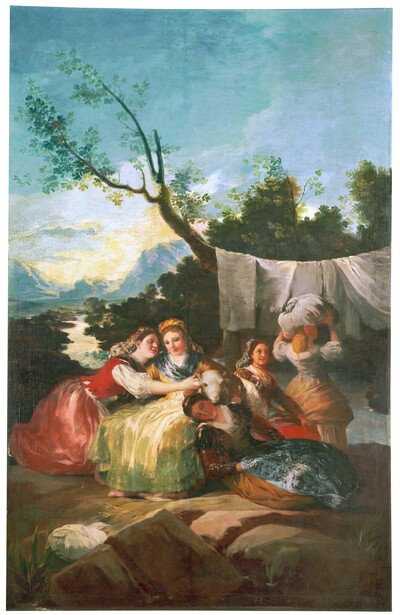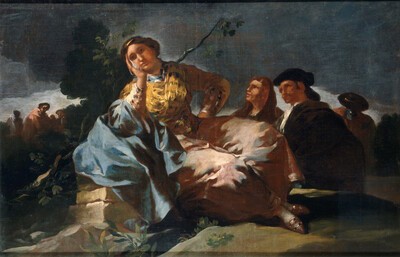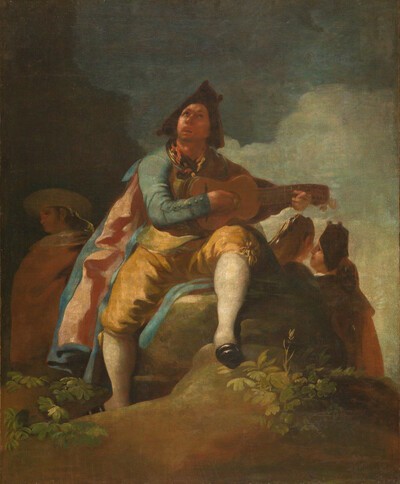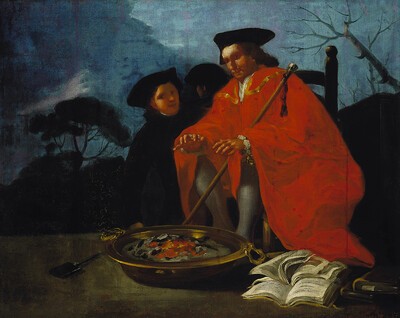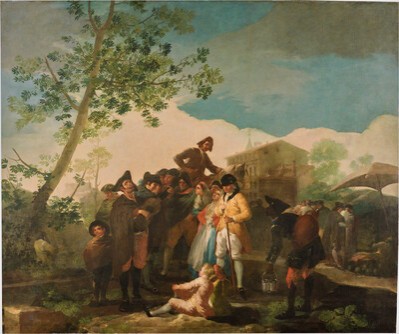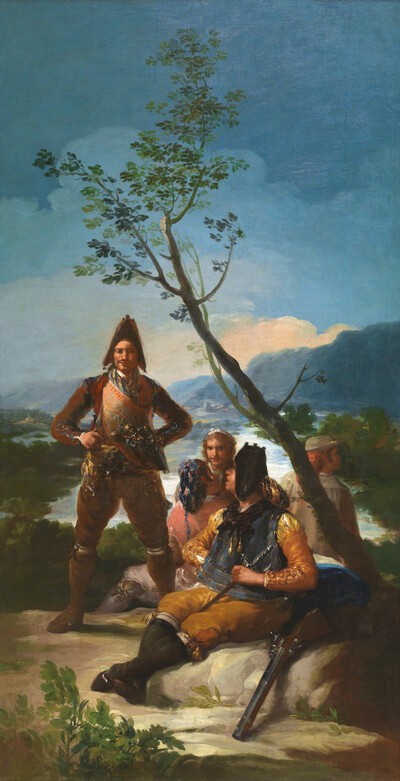- Cronología
- 1779
- Ubicación
- The Prado National Museum. Madrid, Madrid, Spain
- Dimensiones
- 260 x 165 cm
- Técnica y soporte
- Oil on canvas
- Reconocimiento de la autoría de Goya
- Documented work
- Titular
- El Prado National Museum
- Ficha: realización/revisión
- 24 Nov 2009 / 14 Jun 2023
- Inventario
- (P00785)
See The Blind Guitarist.
This cartoon was delivered to the Royal Tapestry Factory, together with A Stickball Game, on 20 July 1779.
Around 1856 or 1857, the cartoon was moved from the Royal Tapestry Factory of Santa Bárbara to the Royal Palace in Madrid. In 1870, it was taken to the Prado Museum under orders given on 18 January and 9 February.
The tapestry of The Swing was hung on the north wall of the antechamber to the royal bedroom, along with The Washerwomen, the overdoor pieces The Woodcutters and Majo with Guitar and the corner-pieces Boy with a Bird and Boy and a Tree.
Goya describes this cartoon as depicting a family, with four children and three maids, out enjoying themselves in the countryside. One of the women sits on the swing and forms the topmost part of the pyramid composition.
There has been talk of the influence of French rococo in this work, due to the image of the swing, although Sambricio is of the opinion that there exist many differences between this cartoon and French works on the same subject.
Tomlinson states that The Swing is a representation of the three ages of man, personified by the children, the young maid on the swing who looks out towards the viewer, and the older maid, dressed in red, who observes the ages through which she has already passed. The same author also reminds us of the sexual connotations of the swing, which would symbolize female fickleness, and its rising movement, symbolizing the sexual arousal provoked by women. Two male figures are indeed present further back in the composition, watching the women, as occurs in other cartoons such as The Haw Seller or The Soldier and the Lady, where Goya testifies to the availability of the woman, and perhaps to her vulnerability, too. Here, though, the effect of Goya's work is more sombre and the figure pushing the young woman on the swing is a c and hild, and not a suitor as occurs in other cases.
The darkening of the pigments caused by the reddish preparation employed by Goya is particularly evident in this cartoon.
-
Goya. 250 AniversarioMuseo Nacional del PradoMadrid1996consultant editor Juan J. Luna. From March 29th to June 2nd 1996cat. 25
-
Permanencia de la memoria, cartones para tapiz y dibujos de GoyaMuseo de ZaragozaZaragoza1997organized by Gobierno de Aragón, Museo Nacional del Prado and Patrimonio Nacional, consultant editor Fernando Checa Cremades. From February 14th to April 6th 1997cat. 10
-
Goya. La imagen de la mujerMuseo Nacional del PradoMadrid2001from October 30th 2001 to February 10th 2002. Exhibitied also at the National Gallery of Art, Washington, March 10th to June 2nd 2002, consultant editor Francisco Calvo Serrallercat. 4
-
L'œuvre peint de Goya. 4 volsParís1928-1950vol. I, p. 78, cat. 19
-
Tapices de GoyaMadridPatrimonio Nacional1946pp. 85, 113, 230, cat. 28 y láms. 118-12
-
Vie et ouvre de Francisco de GoyaParísOffice du livre1970pp. 76, 89, cat. 131
-
BarcelonaPolígrafa1970vol. I, p. 248, cat. 83
-
L’opera pittorica completa di GoyaMilanRizzoli1974pp. 95-96, cat. 89
-
Francisco de Goya, 4 vols.ZaragozaCaja de Ahorros de Zaragoza, Aragón y Rioja1980-1982vol. I, p. 111 y p. 161 (il.)
-
Imagen de GoyaMadridLumen1983p. 89
-
Francisco de Goya, cartones y tapicescol. col. "Espasa Arte"Espasa Calpe1987pp. 102, 113, 271, cat. 32C y p. 103 (il
-
Francisco de Goya. Los cartones para tapices y los comienzos de su carrera en la corte de Madridcol. col. "Ensayos de Arte Cátedra"MadridCátedra1987pp. 125-128, 133-134 y p, 130 (il.)
-
Goya. 250 AniversarioMadridMuseo del Prado1996pp. 305-306, cat. 25 y p. 100 (il.)
-
Salas del Palacio Real de El Pardo para las que se tejieron tapices sobre cartones de Francisco de Goya: identificación de las habitaciones y ajuste de las obras de Goya en los alzados de las paredesin HERRERO CARRETERO, Concha (curator, Tapices y cartones de Goya (catalogue of the exhibition organizated at the Palacio Real de Madrid, from may to june 1996)MadridPatrimonio Nacional, Goya 96, Lunwerg1996p. 169 (il.)

